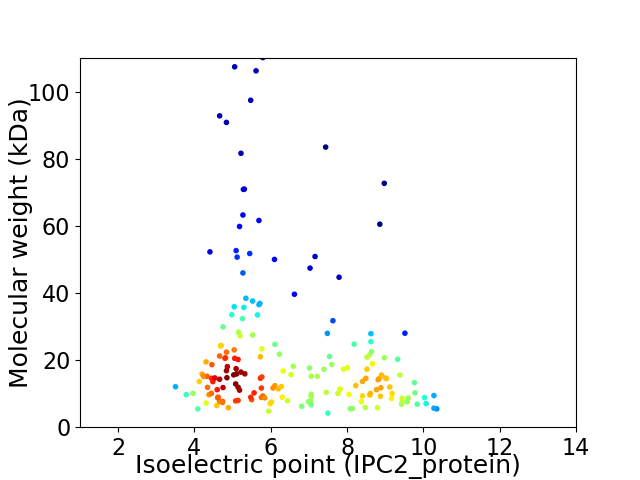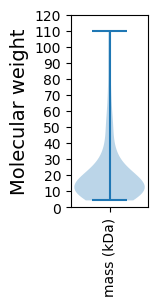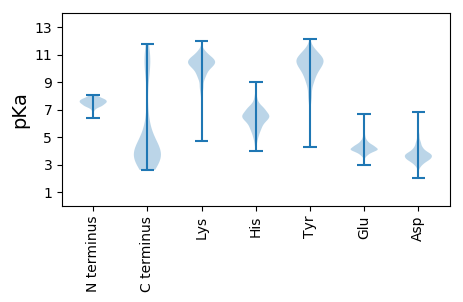
Vibrio phage Ceto
Taxonomy: Viruses; Duplodnaviria; Heunggongvirae; Uroviricota; Caudoviricetes; Caudovirales; Demerecviridae; Ermolyevavirinae; Cetovirus; Vibrio virus Ceto
Average proteome isoelectric point is 6.45
Get precalculated fractions of proteins

Virtual 2D-PAGE plot for 181 proteins (isoelectric point calculated using IPC2_protein)
Get csv file with sequences according to given criteria:
* You can choose from 21 different methods for calculating isoelectric point
Summary statistics related to proteome-wise predictions



Protein with the lowest isoelectric point:
>tr|A0A2H5BGR2|A0A2H5BGR2_9CAUD Macro domain-containing protein OS=Vibrio phage Ceto OX=2570300 GN=CETO_176 PE=4 SV=1
MM1 pKa = 7.75ADD3 pKa = 3.23FWDD6 pKa = 3.36KK7 pKa = 11.22HH8 pKa = 4.61LTKK11 pKa = 9.82EE12 pKa = 3.97QQYY15 pKa = 10.59EE16 pKa = 4.19IVDD19 pKa = 4.28SVAGTCDD26 pKa = 3.11TGCNAEE32 pKa = 4.07YY33 pKa = 8.82WQKK36 pKa = 11.08EE37 pKa = 3.99FGFSNEE43 pKa = 4.33VRR45 pKa = 11.84DD46 pKa = 3.92EE47 pKa = 4.47LNWDD51 pKa = 4.02FPSLAAKK58 pKa = 10.51FEE60 pKa = 4.34LFRR63 pKa = 11.84CEE65 pKa = 4.38DD66 pKa = 3.84CMWWGDD72 pKa = 3.46MGEE75 pKa = 4.25VGDD78 pKa = 4.54CNEE81 pKa = 4.77CGGEE85 pKa = 4.11LVV87 pKa = 3.95
MM1 pKa = 7.75ADD3 pKa = 3.23FWDD6 pKa = 3.36KK7 pKa = 11.22HH8 pKa = 4.61LTKK11 pKa = 9.82EE12 pKa = 3.97QQYY15 pKa = 10.59EE16 pKa = 4.19IVDD19 pKa = 4.28SVAGTCDD26 pKa = 3.11TGCNAEE32 pKa = 4.07YY33 pKa = 8.82WQKK36 pKa = 11.08EE37 pKa = 3.99FGFSNEE43 pKa = 4.33VRR45 pKa = 11.84DD46 pKa = 3.92EE47 pKa = 4.47LNWDD51 pKa = 4.02FPSLAAKK58 pKa = 10.51FEE60 pKa = 4.34LFRR63 pKa = 11.84CEE65 pKa = 4.38DD66 pKa = 3.84CMWWGDD72 pKa = 3.46MGEE75 pKa = 4.25VGDD78 pKa = 4.54CNEE81 pKa = 4.77CGGEE85 pKa = 4.11LVV87 pKa = 3.95
Molecular weight: 10.08 kDa
Isoelectric point according different methods:
Protein with the highest isoelectric point:
>tr|A0A2H5BGM5|A0A2H5BGM5_9CAUD Uncharacterized protein OS=Vibrio phage Ceto OX=2570300 GN=CETO_165 PE=4 SV=1
MM1 pKa = 8.01DD2 pKa = 4.66RR3 pKa = 11.84RR4 pKa = 11.84HH5 pKa = 6.23KK6 pKa = 11.02LRR8 pKa = 11.84VNWHH12 pKa = 6.27RR13 pKa = 11.84RR14 pKa = 11.84LKK16 pKa = 10.67DD17 pKa = 3.35DD18 pKa = 5.35EE19 pKa = 4.14IAIEE23 pKa = 4.07NGFTTRR29 pKa = 11.84LFKK32 pKa = 9.91QTEE35 pKa = 4.38VYY37 pKa = 9.9MYY39 pKa = 10.76DD40 pKa = 3.98LSWWDD45 pKa = 3.37YY46 pKa = 10.54PRR48 pKa = 11.84RR49 pKa = 11.84TLEE52 pKa = 4.11RR53 pKa = 11.84SWKK56 pKa = 8.9NQSKK60 pKa = 10.1KK61 pKa = 9.47RR62 pKa = 11.84KK63 pKa = 6.39QWEE66 pKa = 3.91RR67 pKa = 3.3
MM1 pKa = 8.01DD2 pKa = 4.66RR3 pKa = 11.84RR4 pKa = 11.84HH5 pKa = 6.23KK6 pKa = 11.02LRR8 pKa = 11.84VNWHH12 pKa = 6.27RR13 pKa = 11.84RR14 pKa = 11.84LKK16 pKa = 10.67DD17 pKa = 3.35DD18 pKa = 5.35EE19 pKa = 4.14IAIEE23 pKa = 4.07NGFTTRR29 pKa = 11.84LFKK32 pKa = 9.91QTEE35 pKa = 4.38VYY37 pKa = 9.9MYY39 pKa = 10.76DD40 pKa = 3.98LSWWDD45 pKa = 3.37YY46 pKa = 10.54PRR48 pKa = 11.84RR49 pKa = 11.84TLEE52 pKa = 4.11RR53 pKa = 11.84SWKK56 pKa = 8.9NQSKK60 pKa = 10.1KK61 pKa = 9.47RR62 pKa = 11.84KK63 pKa = 6.39QWEE66 pKa = 3.91RR67 pKa = 3.3
Molecular weight: 8.71 kDa
Isoelectric point according different methods:
Peptides (in silico digests for buttom-up proteomics)
Below you can find in silico digests of the whole proteome with Trypsin, Chymotrypsin, Trypsin+LysC, LysN, ArgC proteases suitable for different mass spec machines.| Try ESI |
 |
|---|
| ChTry ESI |
 |
|---|
| ArgC ESI |
 |
|---|
| LysN ESI |
 |
|---|
| TryLysC ESI |
 |
|---|
| Try MALDI |
 |
|---|
| ChTry MALDI |
 |
|---|
| ArgC MALDI |
 |
|---|
| LysN MALDI |
 |
|---|
| TryLysC MALDI |
 |
|---|
| Try LTQ |
 |
|---|
| ChTry LTQ |
 |
|---|
| ArgC LTQ |
 |
|---|
| LysN LTQ |
 |
|---|
| TryLysC LTQ |
 |
|---|
| Try MSlow |
 |
|---|
| ChTry MSlow |
 |
|---|
| ArgC MSlow |
 |
|---|
| LysN MSlow |
 |
|---|
| TryLysC MSlow |
 |
|---|
| Try MShigh |
 |
|---|
| ChTry MShigh |
 |
|---|
| ArgC MShigh |
 |
|---|
| LysN MShigh |
 |
|---|
| TryLysC MShigh |
 |
|---|
General Statistics
Number of major isoforms |
Number of additional isoforms |
Number of all proteins |
Number of amino acids |
Min. Seq. Length |
Max. Seq. Length |
Avg. Seq. Length |
Avg. Mol. Weight |
|---|---|---|---|---|---|---|---|
0 |
36038 |
35 |
1018 |
199.1 |
22.45 |
Amino acid frequency
Ala |
Cys |
Asp |
Glu |
Phe |
Gly |
His |
Ile |
Lys |
Leu |
|---|---|---|---|---|---|---|---|---|---|
7.678 ± 0.356 | 1.246 ± 0.096 |
6.299 ± 0.144 | 6.92 ± 0.212 |
4.082 ± 0.146 | 6.396 ± 0.173 |
2.048 ± 0.116 | 6.26 ± 0.15 |
7.437 ± 0.151 | 8.585 ± 0.186 |
Met |
Asn |
Gln |
Pro |
Arg |
Ser |
Thr |
Val |
Trp |
Tyr |
|---|---|---|---|---|---|---|---|---|---|
2.594 ± 0.093 | 5.025 ± 0.14 |
3.535 ± 0.141 | 3.605 ± 0.127 |
4.512 ± 0.15 | 6.008 ± 0.23 |
6.096 ± 0.188 | 6.313 ± 0.156 |
1.423 ± 0.083 | 3.938 ± 0.136 |
Most of the basic statistics you can see at this page can be downloaded from this CSV file
Proteome-pI is available under Creative Commons Attribution-NoDerivs license, for more details see here
| Reference: Kozlowski LP. Proteome-pI 2.0: Proteome Isoelectric Point Database Update. Nucleic Acids Res. 2021, doi: 10.1093/nar/gkab944 | Contact: Lukasz P. Kozlowski |
